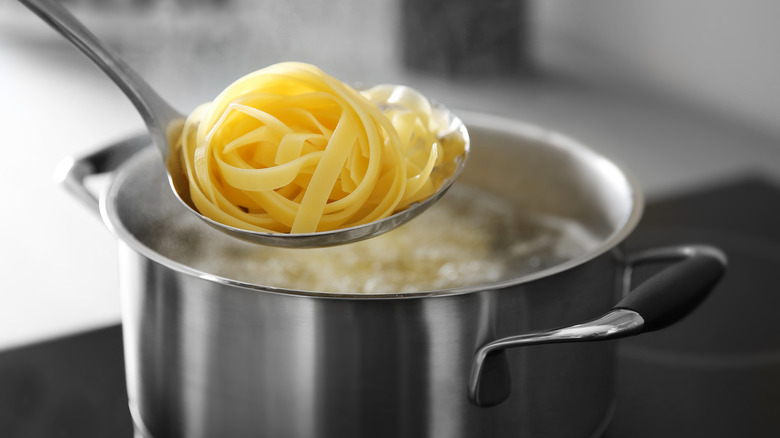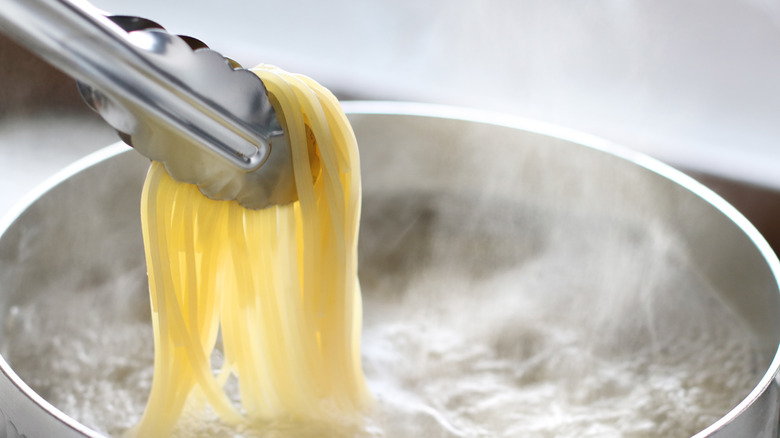Giada De Laurentiis' Tip For Draining Pasta Without Losing Any Water
You've probably heard time and again that you should save your pasta water when cooking. It may not look particularly appetizing, but the starchy water, also known as liquid gold, can work wonders when added to pasta sauce, helping to create a velvety texture and rich creaminess to the sauce that clings perfectly to every strand. But, if you often find yourself draining the pasta in a colander, and watching the precious cloudy water draining way before you remembered to save a cup, Giada De Laurentiis has a tip to help.
Unsurprisingly, Italian-born De Laurentiis has many go-to tips for cooking pasta, and the way she chooses to strain her cooked pasta ensures that the water always stays safe. She uses a spider, or strainer, to remove the pasta from the water and then transfers it to a skillet or bowl. This means that all of the starchy liquid stays in the pan.
The beauty of De Laurentiis' method is that it saves the full volume of the water you've used to cook the pasta. So, whether you only need a few tablespoons, a ladle, or a couple of cups of the stuff, there's plenty to go around, and you can adjust the quantities as needed.
Giada uses a pasta spider to save the water
When her pasta is cooked perfectly al dente, Giada De Laurentiis scoops it out with a spider. It's a simple technique, but it means that the water the pasta has cooked in remains in the pan, rather than being tipped away. And, if your sauce is already heated through in a skillet on the stove, which is by far the best method to do so, in order for the hot pasta and hot sauce to come together properly, it means you can add the strained noodles directly to the sauce using the spider once again.
De Laurentiis advises home cooks never to rinse the pasta once cooked, since that removes the precious starches. Rather, add the noodles straight to the sauce and toss to combine. Then, add a little of the pasta water, so that the magic can happen. Well okay, not so much magic as emulsification. The starch in the cloudy pasta water helps to improve the consistency of sauces, so they feel smoother and more velvety. But, it also emulsifies it with fats such as cream, butter, oil, or cheese, so that the sauce clings better to the strands.
As for how much of the water to use, it will depend on the pasta and the sauce in question; around two cups of water for each pound of pasta is a standard guideline. But another good rule is to start by adding a cup and see if that's enough to create a silky, emulsified sauce; add more if not.
Other ways to drain pasta without losing the liquid gold
If you don't have a pasta spider, which works best to remove shorter shapes of pasta such as penne, fusilli, or orecchiette, there are other ways you can drain the noodles to ensure that you don't lose any of the liquid gold water. Try using a set of tongs to remove longer pasta shapes such as spaghetti, fettuccine, or pappardelle. A spoon-shaped claw also works well for long pasta. Or go for a pasta fork, which can be used with any size or shape of noodle.
If you prefer using a colander, then just remember to scoop out and save a cup or two of the pasta water before you fully drain it. You could always place a bowl beneath the colander to catch the water. Or if you have one, use a pot with a pasta strainer insert so the water is automatically saved, making it even easier.
If it's too late, and you need to know what to do when you accidentally dump out your pasta water, then don't panic. You can actually make your own approximation of it in a pinch by mixing cold water with semolina flour. But, if you follow Giada De Laurentiis' advice and remove the pasta from the water rather than draining it, this will never be an issue; you'll have a good supply of liquid gold every time.



